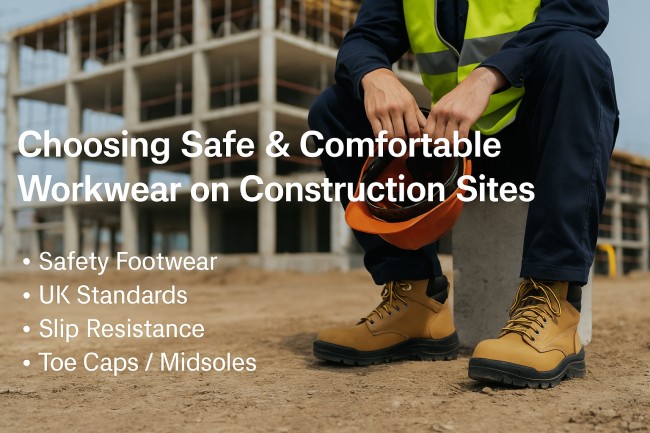Comfort and protection: What should new starters look for in workwear on site?

Starting a new job in construction or site work presents challenges besides learning new skills and procedures. Choosing appropriate workwear, particularly safety footwear, can impact both your daily comfort and long-term wellbeing. With the UK construction industry employing approximately 2.06 million people as of 2024, new workers joining this vital sector need reliable guidance on choosing protective equipment that meets both safety standards and personal comfort requirements.
Know the Latest UK Safety Rules
Recent updates to safety footwear regulations are reshaping workplace protection standards across UK construction sites. The new EN ISO 20345:2022 standard introduces improved labelling requirements that clearly indicate whether boots provide waterproof protection, slip resistance, or defence against sharp objects. These updated standards include mandatory slip resistance testing and improved markings such as the LG (ladder grip) certification for enhanced traction when climbing.
For new starters, understanding these standards guarantees compliance with current regulations whilst guaranteeing optimal protection. The updated classifications replace previous SRA, SRB, and SRC slip resistance markings with clearer SR designations, making it easier to identify appropriate footwear for specific workplace conditions. Employers increasingly require boots meeting these updated standards, making familiarity with the new regulations essential for job readiness.
Look for the Right Safety Features
Different construction roles demand specific protective features in safety footwear. Steel or composite toe caps give essential protection against falling objects, offering 200-joule impact resistance and 15 kN compression protection. Composite materials offer equivalent protection whilst lowering weight and eliminating thermal conductivity issues that can cause discomfort in extreme temperatures.
Slip-resistant soles become important when working on wet surfaces, near water features, or in areas where spillages commonly occur. Penetration-resistant midsoles protect against sharp objects like nails, metal shards, or broken glass that frequently litter construction sites. For roles involving exposure to chemicals or fuel, FO-rated (fuel oil resistant) materials prevent sole degradation and maintain protective integrity throughout the working day.
Comfort Matters Too
Modern safety footwear design prioritises comfort alongside protection, recognising that uncomfortable workers are less productive and more likely to experience foot-related health issues. Advanced materials, including lightweight composites, breathable fabrics, and shock-absorbing midsoles, reduce fatigue during long shifts. Ergonomic insoles and arch support systems help prevent common problems such as plantar fasciitis and lower back pain. Construction workers face significant injury risks, with 51 deaths reported in the sector during 2023/24 according to HSE statistics, making proper protective equipment absolutely essential.
Try Them On Properly
Proper fitting is the most critical aspect of safety footwear selection, yet many workers rush this essential process. Always try on safety boots later in the day when feet naturally swell slightly, providing a more accurate representation of fit during working hours. Make sure there’s adequate toe room by checking you can wiggle your toes freely whilst maintaining heel stability. Test boots through actual movements you’ll perform at work, including walking, crouching, climbing, and balancing. The arch support should feel comfortable immediately without requiring a “breaking-in” period, as properly fitted safety boots should feel comfortable from day one.
Take Care of Your Boots
Proper maintenance extends footwear lifespan whilst preserving protective capabilities essential for workplace safety. Clean boots regularly to remove debris, chemicals, and moisture that can compromise materials and lower protection levels. Allow thorough drying between shifts, using newspaper or dedicated boot dryers to maintain shape whilst removing moisture that can cause bacterial growth and odours.
Regular inspection identifies wear patterns, sole deterioration, and structural damage that could compromise safety. Check toe caps for dents or cracks, examine soles for worn tread patterns, and inspect uppers for tears or chemical damage. Most quality safety boots last six to twelve months with daily use, but replacement becomes necessary when protective features show signs of compromise. Worn or damaged boots represent false economy and potential safety hazards that no worker should accept.

